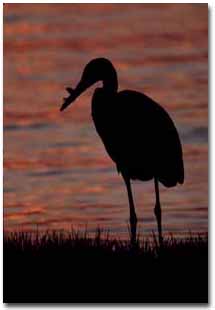
On South Marsh Island, the emphasis is on "marsh." This 3,000 acre island, located within the Chesapeake Bay, is entirely comprised of marshlands, punctuated by ponds and creeks. The marsh was once a convenient hiding place for "picaroons," or pirates, who harassed unprotected American ships during the Revolutionary War. In Kedges Strait, south of the island, the Maryland Navy once engaged the picaroons in a definitive battle.
What To See
The endangered peregrine falcon nests on towers once used to reintroduce young falcons into the wild. The expansive marsh habitat attracts other uncommon birds, like the American oystercatcher, the black skimmer and the black rail. Barn owls use nest boxes on the island from April to September. The island is best viewed by boat. Visitors can walk on the marsh; however, deep, wet soils make hip boots or even chest waders appropriate apparel.
What To Do
Hunters will find large populations of waterfowl like gadwall, black duck, mallard, scaup and Canada geese. Visitors will enjoy crabbing and fishing for trout, rockfish, croaker, bluefish and spot in the waters near South Marsh and along the shoreline. Trapping is offered by yearly lease. South Marsh Island is a 5-mile boat trip across the open waters of Tangier Sound.
Area Regulations
- Use of South Marsh Island WMA is generally permitted seven days a week throughout the year.
- Hunting is allowed in accordance with open seasons and shooting hours, unless otherwise noted.
- All State and Federal Hunting Laws and Regulations are applicable.
- Trapping is by permit only.
- No motorized vehicles are allowed.
Non-hunting Users Guide
- Non-hunting visitors are welcome.
- Be aware of open hunting seasons and visit accordingly.
- Season dates available in newspapers, on the Internet, and at some area stores.
- The island is best viewed by boat, but visitor's can walk on the marsh.
- The endangered peregrine falcon nests on towers once used to reintroduce young falcons into the wild.
- The expansive marsh habitat attracts other uncommon birds, like the American oystercatcher, the black skimmer and the black rail.
- Barn owls use nest boxes on the island from April to September.
- Visitors to the management area should be aware that there may be biting flies, mosquitoes, and ticks present during April - November.
Site Management Goals
- Nest boxes for Barn owls have been erected to supplement natural tree cavities for nesting.
- Peregrine falcons nest on towers that have been erected as part of the Eastern Peregrine Falcon Recovery Plan.
- Tidal marsh habitat conditions on the island limit management practices that can be implemented.
 Directions
Directions
South Marsh Island WMA is located in western Somerset County. Access is by boat only. Public ramps are available at Deal Island via MD Route 363 and Crisfield via MD Route 413. Access both of these roads from U.S. Route 13. For additional information, contact the Wellington Wildlife Office at (410) 651-2065.
 Click Here for Map
Click Here for Map
This area is a part of Maryland’s Department of Natural Resources public land system and is managed by the Wildlife and Heritage Service. The primary mission of the WMA system is to conserve and enhance wildlife populations and their respective habitats as well as to provide public recreational use of the State’s wildlife resources.
Eighty-five percent of the funding for Maryland's state wildlife programs comes from hunting license fees and a federal excise tax on sport hunting devices and ammunition. The federal aid funds are derived from the Federal Aid in Wildlife Restoration (or Pittman-Robertson) Fund, which sportsmen and women have been contributing to since 1937. Each state receives a share of the funds, which is administered by the U. S. Fish and Wildlife Service; these funds are used for wildlife conservation and hunter education programs, including the management of the WMA system.
Other sources of funds for land acquisition include Program Open Space Funding for Maryland's State and local parks and conservation areas, provided through The Department of Natural Resources' Program Open Space. Established in 1969, Program Open Space symbolizes Maryland's long-term commitment to conserving natural resources while providing exceptional outdoor recreation opportunities.